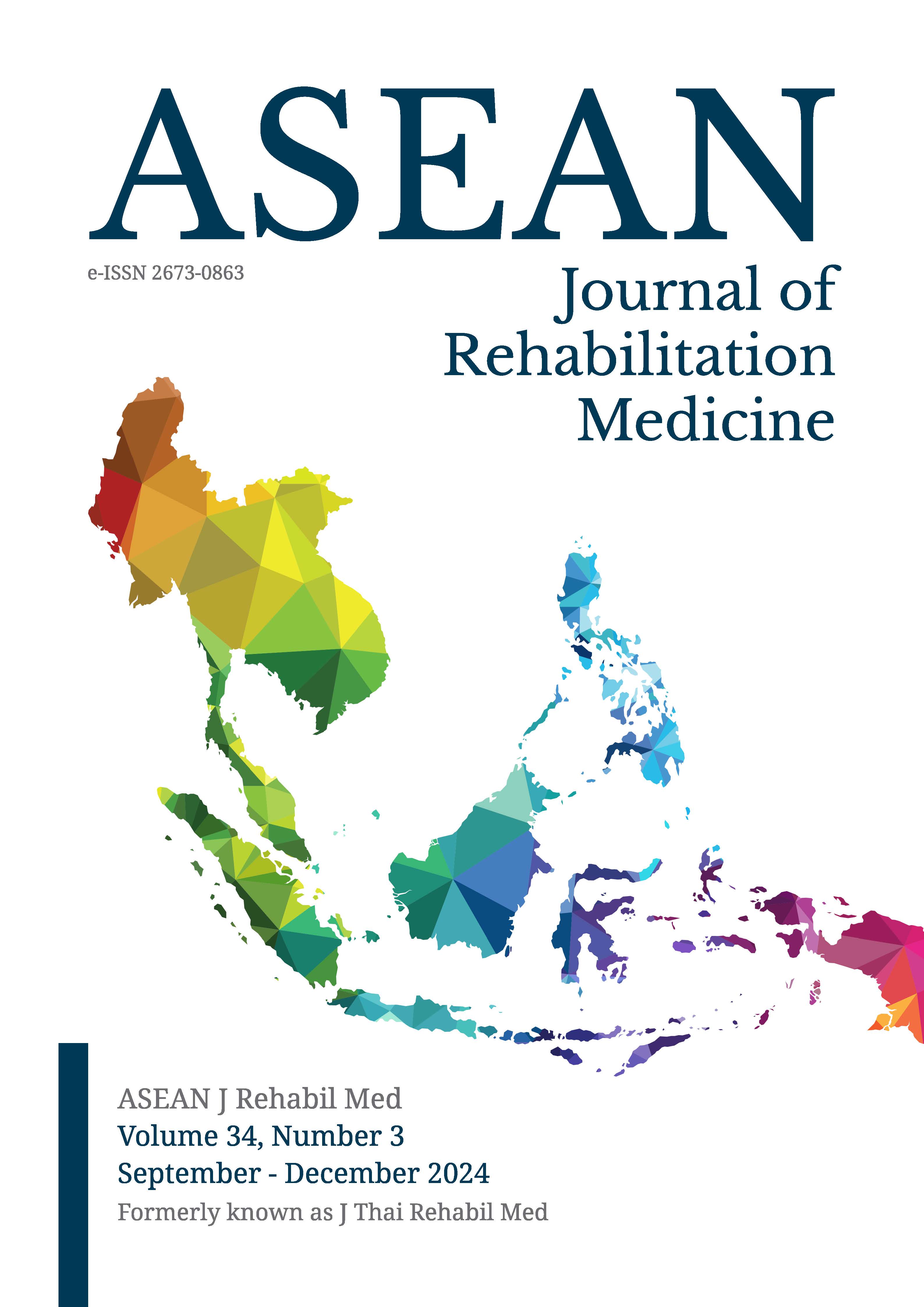Reliability and Validity of a Thai Version of a Modified Frenchay Activities Index for Use with Stroke Patients
Keywords:
Frenchay Activities Index (FAI), instrumental activities of daily living (IADL), reliability, validity, right hemispheric stroke, strokeAbstract
Objectives: To evaluate the reliability and validity of the Thai version of the modified Frenchay Activities Index (mFAI) questionnaire for use with stroke patients
Study design: Descriptive study
Setting: Department of Rehabilitation Medicine and Neurology Division, Department of Medicine, Faculty of Medicine, Siriraj Hospital, Mahidol University, Bangkok, Thailand
Subjects: Stroke patients visiting the Outpatient Department of the Rehabilitation Medicine and Neurology Division, Department of Medicine, from March 2020 to August 2020
Methods: Data were collected using a Thai version of the modified Frenchay Activities Index (Thai-mFAI). Of 75 patients, 70 met the inclusion criteria. After the initial assessment, all 70 participants were reassessed 3-7 days later to determine test-retest reliability. Validity was assessed from 59 participants by evaluating the correlation between the Stroke-Impact Scale (SIS) and the timed up-and-go test (TUG).
Results: The Thai-mFAI showed good content validity (CVI = 0.95), fair construct validity (convergent validity; r=0.287-0.310, discriminant validity; r=-0.259), excellent test-retest reliability (ICC3,1=0.929) and excellent internal consistency (Cronbach’s alpha = 0.936).
Conclusions: The Thai-mFAI was found to have good content validity, fair construct validity, excellent test-retest reliability, and excellent internal consistency. These suggested that Thai-mFai is suitable for evaluating how well active stroke patients can perform activities of daily living.
References
Sharma VK. Cerebrovascular Disease. In: Quah SR, editor. International encyclopedia of public health. 2nd ed. Oxford: Academic Press; 2017. p. 455-70.
Suwanwela NC. Stroke epidemiology in Thailand. J Stroke. 2014; 16:1-7.
Feigin VL, Brainin M, Norrving B, Martins S, Sacco RL, Hacke W, et al. World Stroke Organization (WSO): Global stroke fact sheet 2022. Int J Stroke. 2022;17:18-29.
World Stroke Organization: (WSO). Up again after stroke [Internet]. [cited 2024 May 12]. Available from: http://www.worldstrokecampaign.org/
Sarker SJ, Rudd AG, Douiri A, Wolfe CD. Comparison of 2 extended activities of daily living scales with the Barthel Index and predictors of their outcomes: cohort study within the South London Stroke Register (SLSR). Stroke. 2012;43:1362-9.
Wade DT, Legh-Smith J, Langton Hewer R. Social activities after stroke: measurement and natural history using the Frenchay Activities Index. Int Rehabil Med. 1985;7:176-81.
Wu CY, Chuang LL, Lin KC, Horng YS. Responsiveness and validity of two outcome measures of instrumental activities of daily living in stroke survivors receiving rehabilitative therapies. Clin Rehabil. 2011;25:175-83.
Holbrook M, Skilbeck CE. An activities index for use with stroke patients. Age Ageing. 1983;12:166-70.
Wendel KA, Stahl A, Iwarsson S. Inter-rater agreement of a modified and extended Swedish version of the Frenchay Activities Index (FAI). Eur J Ageing. 2013;10:247-55.
Imam B, Miller WC. Reliability and validity of scores of a Chinese version of the Frenchay Activities Index. Arch Phys Med Rehabil. 2012;93:520-6.
Beaton DE, Bombardier C, Guillemin F, Ferraz MB. Guidelines for the process of cross-cultural adaptation of self-report measures. Spine (Phila Pa 1976). 2000;25(24):3186-91.
Rinthaisong I. Determination of content precision by the content validity index [Internet]. Songkla: Department of public administration, Faculty of management, Prince of Songkla University [Internet]. 2014 [cited 2020 Sep 5]. Available from: https://sites.google.com/site/stats2researchs/student-of-the-month/johndoe
Garnjanagoonchorn A, Dajpratham P. Reliability and validity of the Thai version of the stroke impact scale (SIS) 3.0. J Thai Rehabil Med. 2015;25:45-52.
Chan PP, Si Tou JI, Tse MM, Ng SS. Reliability and validity of the Timed Up and Go test with a motor task in people with chronic stroke. Arch Phys Med Rehabil. 2017;98:2213-20.
Whitney JC, Lord SR, Close JC. Streamlining assessment and intervention in a falls clinic using the Timed Up and Go test and physiological profile assessments. Age Ageing. 2005;34:567-71.
Brooks D, Davis AM, Naglie G. Validity of 3 physical performance measures in inpatient geriatric rehabilitation. Arch Phys Med Rehabil. 2006;87:105-10.
Colton T. Statistics in medicine. Boston: Little, Brown; 1974.
Taber KS. The use of Cronbach’s Alpha when developing and reporting research instruments in science education. Research in science education. 2018;48(6):1273-96.
Koo TK, Li MY. A guideline of selecting and reporting intraclass correlation coefficients for reliability research. J Chiropr Med. 2016;5:155-63.
Lin KC, Chen HF, Wu CY, Yu TY, Ouyang P. Multidimensional Rasch validation of the Frenchay Activities Index in stroke patients receiving rehabilitation. J Rehabil Med. 2012;44:58-64.
Tse T, Douglas J, Lentin P, Carey L. Measuring participation after stroke: a review of frequently used tools. Arch Phys Med Rehabil. 2013;94:177-92.
Downloads
Published
How to Cite
Issue
Section
License

This work is licensed under a Creative Commons Attribution-NonCommercial-NoDerivatives 4.0 International License.






